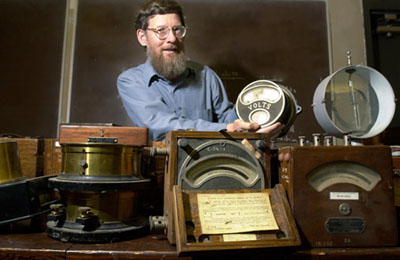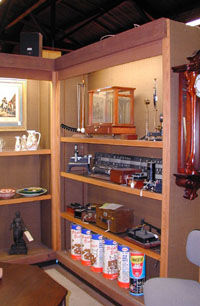|

|

|
NEWS
SEARCH
|
|
|
|

|
 |
| Thomas
Colton of the Physics Department shows off a few of
the hundreds of voltmeters, ampmeters, electroscopes
and resistors unearthed from the attic of LeConte
Hall. Noah Berger photo |
From
attic to auction: antique instruments to raise money for
Physics Department
27
June 2002
By Bonnie Azab Powell, Public Affairs
BERKELEY
- Inside the soaring, wood-beamed warehouse of Oakland's
Harvey Clars auction house, there are enough precious
items to fill several mansions: grand pianos, Art Nouveau
benches, a Henri II dining suite, Persian rugs, Limoges
dinnerware. In their midst huddles an unusual group of
objects, looking as ill at ease as engineers at a costume
ball.
 |
| On
June 30 Harvey Clars will auction off a preview group
of 20 instruments, including a wood-and-brass balance,
a four-foot demonstration slide rule (second shelf)
and Tinker Toys used to build molecular models. |
A
little after 10 a.m. on Sunday, June 30, Harvey Clars will open
the bidding on this handful of antique scientific instruments
— and vintage Tinker Toys used for molecular models —
excavated from storage by UC Berkeley's Physics Department.
This is just a test sale, through which the auction house will
gauge the interest in an additional 400 or so voltmeters, galvanometers,
balances, microscopes, collision-ball apparatuses, demonstration-size
slide rules, and other items it plans to sell July 27-28. The
Physics Department will use the proceeds to buy new equipment
like computers, sensors, and microphones for its undergraduate
laboratories.
The
instruments emerged from decades of seclusion in May,
when the department began preparing to move out of the
older wing of LeConte Hall to allow a seismic retrofit.
In Physics' temporary home, Hearst Annex, space is at
a premium. Thomas Colton, the instructional support group's
director, thus faced the monumental housecleaning challenge
of emptying out a 5,000-square-foot attic (with no elevator
access) as well as numerous basement storage cupboards.
"We
didn't realize how much there was until we actually got up on
ladders and started pulling things out," Colton says. "We thought
we would fill up one lab room, and we did but we weren't even
a quarter of the way finished."
The
storage contents ultimately covered every available inch of
the tables in two laboratories. Colton called in faculty members,
including Professor Emeritus Howard Shugart, to help identify
the instruments, deciding which to set aside for Harvey Clars,
which to consign to the university's Excess and Salvage, and
which to keep for historical interest and as gifts for departing
faculty. The department hopes to acquire display cases for the
equipment for public viewing; until then, it will be stored
in a secure room in Birge Hall.
There
were a lot of duplicates, since many of the instruments
were used by members of entire classes. "When I arrived
here, there were wall-mounted galvanometers all around
the undergraduate labs," says Shugart, who joined the
department in 1953 as a graduate teaching assistant before
becoming a faculty member. "The students used them for
electrical measurement experiments. When transistors and
more modern equipment became available in the late '50s,
early '60s, they just stayed on the walls for about 20
years before finally going into storage."
The
department elected to keep a century-old diffraction grating,
a metal or glass tool with a series of parallel, closely
spaced slits that separate out light across the spectrum.
The oldest identifiable item, the tool bears an inscription
on the surface of the mirror: "Ruled on Professor Rowland's
Engine, John Hopkins University, Baltimore, Maryland,
1895." Henry Rowland, a physics professor, revolutionized
spectroscopy with the superior craftsmanship of his gratings.
|
AUCTION
INFO
Harvey
Clars Auction Gallery
5644 Telegraph Ave.
Oakland, CA 94609
Open for viewing Friday, June 28, 1-6 p.m.
and Saturday, June 29, 10 a.m.-5 p.m.
Auction
starts at 10 a.m., Sunday, June 30. Proceeds
benefit the Berkeley Physics Department. Directions
and more information for buyers at www.harveyclar.com |
 |
Among
the other objects saved were an eight-foot-long demonstration
slide rule, some chemical balances with fine wooden cases and
brass fittings, and a beautiful old ampere balance for measuring
electric current. Shugart remembers using the balance in the
Physics 111 lab, an advanced course for seniors.
There
were no early calculators found. "Years ago [physics professor
Raymond] Birge had a room with six or eight desk calculators
and comptometers that we used for summarizing grades, which
would take me three hours a night," recalls Shugart. "Then in
the mid-'50s Lawrence Berkeley Lab got its first electronic
calculator and cut that time to an hour. I suppose the old ones
went to salvage; I hope somebody bought them."
Consigning
such beautifully crafted, if now useless instruments to
the junkpile was exactly what Colton hoped to avoid. Two
years ago, the Physics Department held an event for high
school science teachers from around the Bay Area. It invited
them to take home some of the most recently outdated equipment,
such as spectroscopes, oscilloscopes and power supplies.
For
this housecleaning, Harvey Clars agreed to take roughly two-thirds
of the items. On a staff member's suggestion, Colton called
the Red Oak Victory Amateur Radio Club in Richmond, California,
to see if it was interested in the remainder. The club's members
are working as volunteers on the restoration of the S.S.
Red Oak Victory, the last remaining cargo ship built at
the Kaiser/Richmond shipyards (launched in 1944). "We had several
boxes of old vacuum tubes and meters that they were thrilled
to have to use for parts," says Colton. In the end, only about
15 percent went to salvage.
Jane
Alexiadis, the appraiser at Harvey Clars handling the sale for
Physics, believes that buyers will be interested in the instruments
for their historical value, and their "beauty as sculpture,
as well as functional, useful objects." She picks up a reflecting
galvanometer (another current-measuring device) covered in Bakelite
that's as heavy as a lead brick: "See, this is so cool —
when you think of Bakelite, it's usually funky jewelry that
comes to mind. But back then they put it on everything."
Alexiadis's
appreciation for old technology is personal as well as professional.
She admits to using a vintage seismograph as her bedside table
and owning a slide-rule tie clip.
Although
one of the large demonstration slide rules stayed on the Berkeley
campus, a four-foot version of the old calculating device will
be in Harvey Clars' preview sale. It may fetch the highest price
of the group: a seven-foot demonstration slide rule from Keuffel
& Esser sold recently on eBay for $499. Also for sale is a Portable
Precision Potentiometer (about as portable as the early personal
computers) by the Rubicon Company, which can fetch between $200
and $500.
Alexiadis
expects the Physics Department instruments to generate
a fair amount of interest. "Last summer we sold a large
collection of antique pharmacy equipment from a professor's
private collection — beautiful balances like these,
hand-blown glass bottles, even a leech jar," she says.
"That sale did great."
Colton,
meanwhile, is more cautious. "I'm trying not to get my
hopes up about the auction. I don't even want to throw
out a number," he says.
Both
he and Shugart plan to attend the July sale and perhaps
bid on items for their personal use. "Some of the brass
spectrometers and dividing circles are just beautiful
craftsmanship, the kind you don't see anymore," explains
Shugart. "Not only do they still function, but they also
look nice."
That's
more than what will likely be said about our computer monitors
and PalmPilots 50 years from now.
|

|